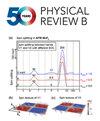Ambipolar doping of a charge-transfer insulator in the Emery model
IF 3.7
2区 物理与天体物理
Q1 Physics and Astronomy
引用次数: 0
Abstract
Understanding the similarities and differences between adding or removing electrons from a charge-transfer insulator may provide insights about the origin of the electron-hole asymmetry found in cuprates. Here we study with cellular dynamical mean-field theory the Emery model set in the charge-transfer insulator regime, and dope it with either electrons or holes. We consider the normal state only and focus on the doping evolution of the orbital character of the dopants and on the nature of the doping-driven transition. Regarding the orbital character of the dopants, we found an electron-hole asymmetry: doped electrons mostly enter the copper orbitals, whereas doped holes mostly enter the oxygen orbitals. Regarding the nature of the doping-driven transition, we found no qualitative electron-hole asymmetry: On either electron or hole doping, there is a two-stage transition from a charge-transfer insulator to a strongly correlated pseudogap and then to a metal. This shows that a strongly correlated pseudogap is an emergent feature of doped correlated insulators in two dimensions, in qualitative agreement with recent experiments on ambipolar Sr1−xLaxCuO2+y cuprate films. Our results indicate that merely doping with holes or electrons a charge-transfer insulator is not sufficient for explaining the electron-hole asymmetry observed in the normal state phase diagram of cuprates. Our work reinforces the view that actual hole-doped cuprates are more correlated than their electron-doped counterparts.Emery模型中电荷转移绝缘体的双极性掺杂
了解从电荷转移绝缘体中添加或移除电子之间的异同,可能有助于了解铜酸盐中发现的电子-空穴不对称的起源。本文用元胞动力学平均场理论研究了电荷转移绝缘子区设置的金刚砂模型,并将其掺杂电子或空穴。我们只考虑正常状态,重点关注掺杂剂轨道特性的掺杂演变和掺杂驱动跃迁的性质。对于掺杂剂的轨道特性,我们发现了电子-空穴的不对称性:掺杂的电子大部分进入铜轨道,而掺杂的空穴大部分进入氧轨道。关于掺杂驱动跃迁的性质,我们没有发现定性的电子-空穴不对称:在电子或空穴掺杂上,都有一个从电荷转移绝缘体到强相关赝隙然后到金属的两阶段转变。这表明,强相关赝隙是掺杂相关绝缘子在二维中出现的特征,这与最近在双极性Sr1−xLaxCuO2+y铜酸盐薄膜上的实验结果在定性上一致。我们的研究结果表明,仅仅在电荷转移绝缘体中掺杂空穴或电子不足以解释铜酸盐正常状态相图中观察到的电子-空穴不对称性。我们的工作强化了这样一种观点,即实际的空穴掺杂铜酸盐比电子掺杂铜酸盐更相关。2025年由美国物理学会出版
本文章由计算机程序翻译,如有差异,请以英文原文为准。
求助全文
约1分钟内获得全文
求助全文
来源期刊

Physical Review B
物理-物理:凝聚态物理
CiteScore
6.70
自引率
32.40%
发文量
0
审稿时长
3.0 months
期刊介绍:
Physical Review B (PRB) is the world’s largest dedicated physics journal, publishing approximately 100 new, high-quality papers each week. The most highly cited journal in condensed matter physics, PRB provides outstanding depth and breadth of coverage, combined with unrivaled context and background for ongoing research by scientists worldwide.
PRB covers the full range of condensed matter, materials physics, and related subfields, including:
-Structure and phase transitions
-Ferroelectrics and multiferroics
-Disordered systems and alloys
-Magnetism
-Superconductivity
-Electronic structure, photonics, and metamaterials
-Semiconductors and mesoscopic systems
-Surfaces, nanoscience, and two-dimensional materials
-Topological states of matter
 求助内容:
求助内容: 应助结果提醒方式:
应助结果提醒方式:


